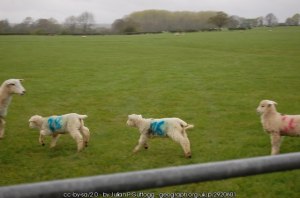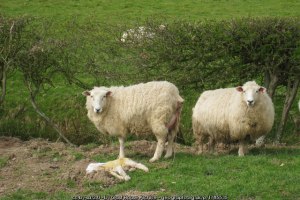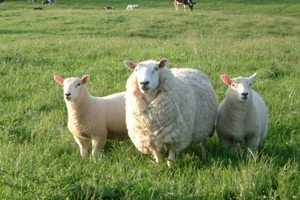Last night Tom said to me, “I’m on lamb checking duty tomorrow morning at 5am if you want to come, but if you do be sure you’re there at 5 sharp ‘cos I won’t hang around!” The rising gale moaned around the eaves as the wind threw handfuls of raindrops against the window panes. I thought of the balmy winter evening I had offered to accompany him on this duty, imagining pastoral scenes with glittering frost underfoot and glittering stars overhead, thought ‘sod’s law’, gulped, and said “I’ll be there”.
I awoke at 1am, 2am, 3am, and lay worrying about the washing left on the line which could well be adorning the overhead sycamore tree by now. And worrying about whether the beautiful ash tree at the foot of our garden would stay rooted. And considering whether to wimp out and stay in bed when the alarm went at 4:40am.
When the alarm went off the roar of the gale had sunk to a hum. No rain pebbles beating the windows. So off to meet Tom and go to the field which is currently the sheep maternity wing of the farm. I don’t know about the name of this field but if you look at the old land use maps you will often see that the small field or sometimes orchard by the farmhouse is called Lambleaze for that reason.
Upon entering the field we flashed our torches around and Tom immediately said, “Look, one’s over there. There’s the rest, there should be 27 altogether.” He counted, somehow seeing distant sheep that were so much in the shadows I could barely see they were there at all. After a couple counts he said “Yeh, there’s 26 there. Let’s get this lamb and ewe into the trailer.”
So we went carefully but purposely up towards the ewe and suddenly Tom was walking beside me holding the lamb, with the ewe nuzzling it as he led her to the safe warmth of the straw-bedded trailer. In they both went, Tom marked the lamb with a special spray so it would not be mixed up with the other lamb and ewe in the trailer, and we were on our way back out of the field ten minutes after arriving.
When the lambs are older they are put into another field separate from the one in which they were given birth. Sheep are happiest outside: it is after all ‘home’ to them. When gales come they huddle into hedgerows for protection from the elements.
Last night, we think it must have been in the teeth of the gale, another lamb pushed deeper and deeper into the hedge….and out the other side. On the other side is the A352. The country lane ancestry of the A352 is unmissable. Unfortunately those bends also meant that lamb was unmissable….


 d foxes we see in the Valley. They are usually rather thin, often mangy. In short, they are often foxes that have moved in for easy pickings because they are old or unwell.
d foxes we see in the Valley. They are usually rather thin, often mangy. In short, they are often foxes that have moved in for easy pickings because they are old or unwell.
